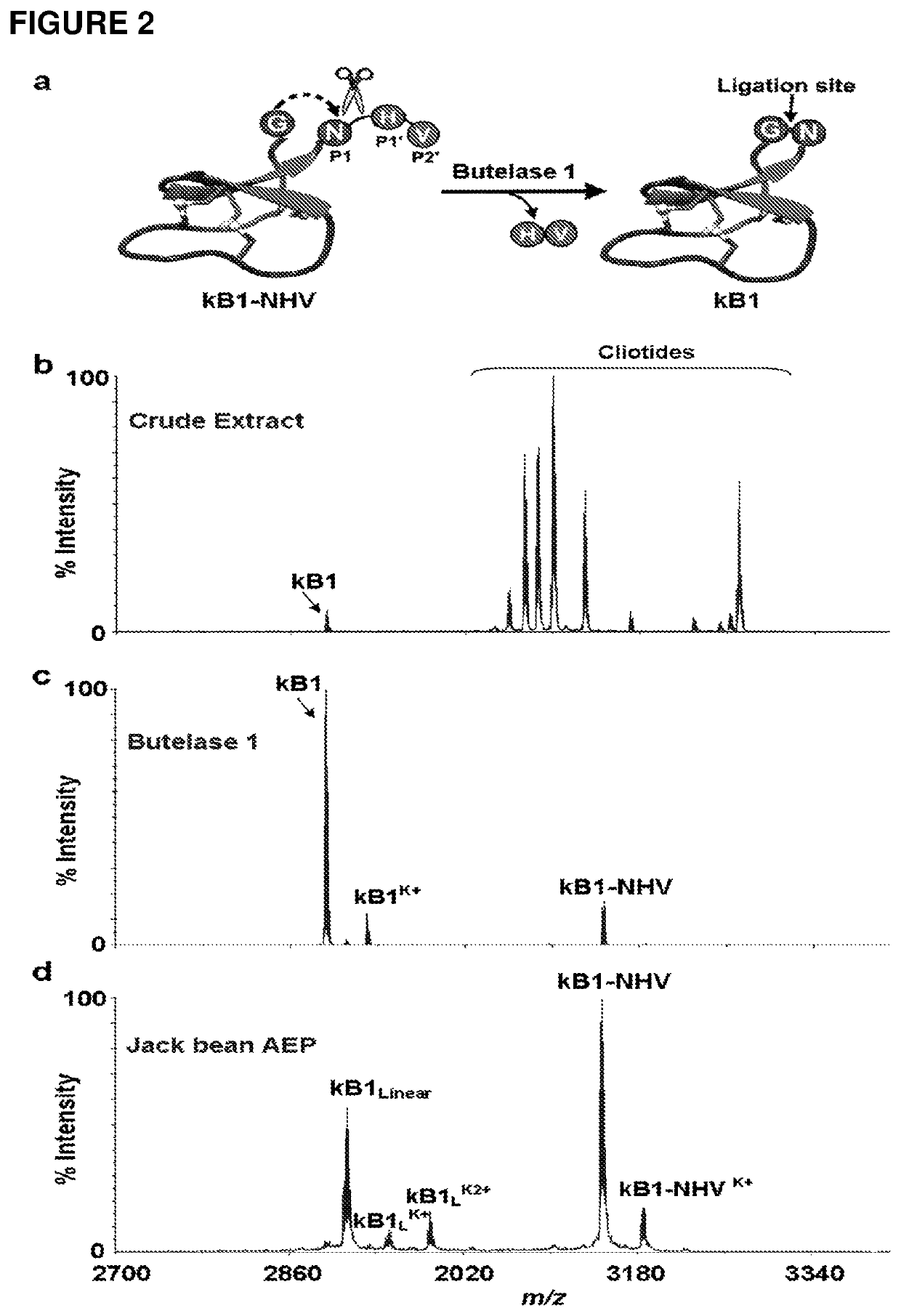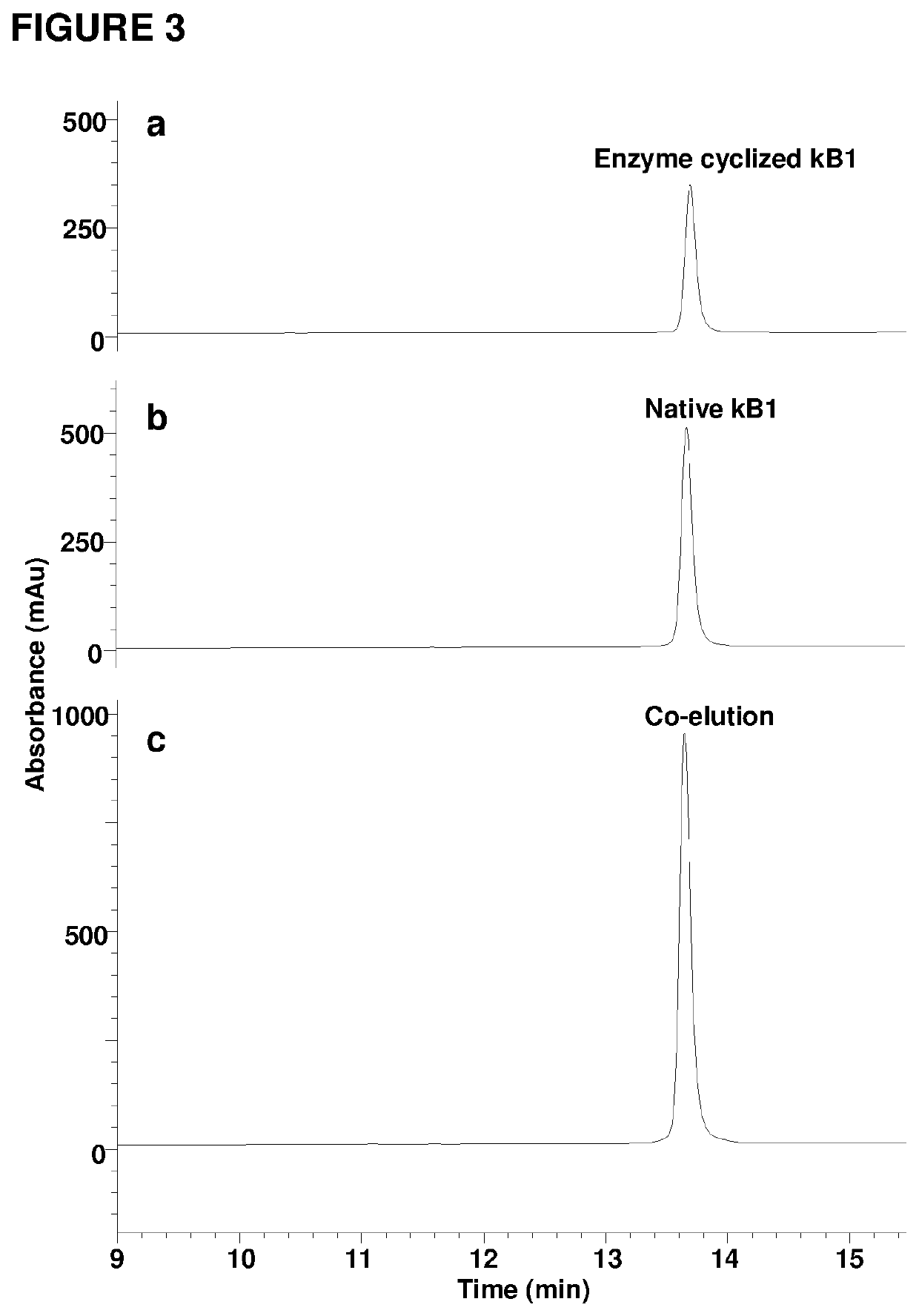Asx-specific protein ligase
a technology of asx-specific proteins and ligases, which is applied in the field of new enzymes with asx-specific ligases and cyclases, can solve the problems of inability to fully exploit various reasons, inability to use chemical methods, and few known peptide cyclases, etc., and achieves the effect of high versatility and usefulness
- Summary
- Abstract
- Description
- Claims
- Application Information
AI Technical Summary
Benefits of technology
Problems solved by technology
Method used
Image
Examples
example 1
In Vitro Screening of Asparaginyl Endopeptidase and Peptide Cyclase Activity
[0116]The asparaginyl endopeptidase (AEP) activity was determined by using the fluorogenic substrate Z-Ala-Ala-Asn-AMC (Z-AAN-AMC), a fluorogenic substrate selective for legumains (Kembhavi, A. A., Buttle, D. J., Knight, C. G. & Barrett, A. J. The two cysteine endopeptidases of legume seeds: purification and characterization by use of specific fluorometric assays. Arch. Biochem. Biophys. 303, 208-213 (1993); Sojka, D. et al. IrAE—An asparaginyl endopeptidase (legumain) in the gut of the hard tick Ixodes ricinus. Int J. Parasitol. 37, 713-724 (2007), at a concentration of 100 mM in buffer A. Emitted fluorescence was measured with an excited wavelength of 380 nm and emission wavelength of 460 nm.
[0117]In a first experiment, the crude extract of C. ternatea was incubated with Z-AAN-AMC under the above-described conditions. A large increase in fluorescence intensity at 460 nm was observed indicating the presence...
example 2
Isolation, Purification, Identification and Characterization of Butelase 1
[0121]Attempts to isolate the peptide ligase guided by Z-AAN-AMC were unsuccessful. Fractions giving strong fluorescence intensity after HPLC separation of the crude extract were unable to cyclize kB1-NHV. Instead, a peptide corresponding to the linear form of kB1 with His-Val being hydrolyzed was observed. All HPLC-separated fractions were then directly screened using kB1-NHV as the substrate, and cyclase activity was found in fractions lacking fluorescence (FIG. 2c). This result demonstrates that the cyclase activity is separate from the AEP activity. As a control, commercial jack bean legumain was unable to cyclize kB1-NHV and generated only the linear form of kB1 (FIG. 2d).
[0122]The putative ligase was purified in several chromatographic steps to give a single protein band of 38 kDa on SDS-PAGE (FIG. 6a). For the isolation and purification 300 g pods of C. ternatea were homogenized with 500 ml of extractio...
example 3
N-Terminal Cyclization Specificity
[0156]To further study the N-terminal specificity of butelase 1 with respect to its cyclase activity, three peptide libraries were synthesized and tested for cyclization:
[0157]
(SEQ ID NO: 157)Peptide library 1:XLYRRGRYLRRNHV(SEQ ID NO: 158)Peptide library 2:XRLYRGRYLRRNHV(SEQ ID NO: 159)Peptide library 3:GXLYRGRYLRRNHV
[0158]In the afore-mentioned peptide libraries X designates any one of the 20 natural amino acids, as defined above. The cyclized peptides have the same sequence as given above, with the exception that the C-terminal residues HV have been cleaved off and the C-terminal N covalently linked to the N-terminal amino acid of the respective peptide. The reaction was performed in the presence of 50 nM butelase 1, 50 μM peptide, 42° C. for 60 min. The results of this cyclization activity test are shown as cyclization yields of the three peptide libraries in FIG. 23a)-c).
[0159]From this experiment, it can be concluded that when the P2″ residue ...
PUM
| Property | Measurement | Unit |
|---|---|---|
| mass | aaaaa | aaaaa |
| wavelength | aaaaa | aaaaa |
| wavelength | aaaaa | aaaaa |
Abstract
Description
Claims
Application Information
 Login to View More
Login to View More - R&D
- Intellectual Property
- Life Sciences
- Materials
- Tech Scout
- Unparalleled Data Quality
- Higher Quality Content
- 60% Fewer Hallucinations
Browse by: Latest US Patents, China's latest patents, Technical Efficacy Thesaurus, Application Domain, Technology Topic, Popular Technical Reports.
© 2025 PatSnap. All rights reserved.Legal|Privacy policy|Modern Slavery Act Transparency Statement|Sitemap|About US| Contact US: help@patsnap.com



